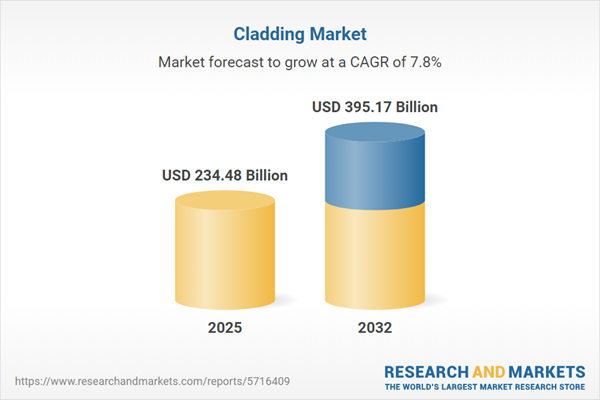Speak directly to the analyst to clarify any post sales queries you may have.
Senior decision-makers in the construction sector face ongoing shifts as cladding strategy rises in importance against new compliance challenges, evolving sustainability demands, and rapid technological progress. Informed, adaptive approaches in the global cladding market are now essential for business continuity and project success.
Market Snapshot: Global Cladding Market Size and Outlook
The global cladding market reached USD 217.41 billion in 2024 and is projected to expand to USD 234.48 billion by 2025. Sustained robust growth is expected through to 2032, supported by a 7.75% CAGR, with an estimated market valuation of USD 395.17 billion by the end of the forecast period. Strong activity across commercial, residential, and institutional construction drives this expansion. Stakeholders are navigating a landscape shaped by increasing regulatory demands and a growing emphasis on sustainable construction practices. Advancements, especially in integrated façade systems and adaptive materials, are shaping procurement, while evolving regional codes and ongoing urbanization continue to create new market opportunities.
Scope & Segmentation of the Global Cladding Market
- Material Types: Covers ceramics, glass, wood, plastics, and a wide array of metals, including aluminum, copper, steel, and zinc. Also includes composite materials options such as fiber reinforced polymers and wood plastic composites, supporting customized architectural performance and compliance needs.
- End Uses: Encompasses hospitality, retail, office spaces, industrial properties, educational institutions, healthcare facilities, and residential buildings. Each sector faces its own set of compliance, safety, and sustainability drivers, influencing procurement and project planning decisions.
- Product Types: Features an array of solutions including boards, prefabricated panels, site-assembled panels, veneers, rain screens, stick systems, and unitized curtain walls. These support modular construction approaches as well as traditional methods for both new and retrofit projects.
- Distribution Channels: Includes direct sales, partnerships with specialty distributors, and digital procurement platforms. These methods help maintain supply continuity and enable flexible sourcing and logistics management.
- Geographical Regions: Addresses markets across the Americas, Europe, Middle East, Africa, and Asia-Pacific. Participants must adapt to varying local building codes, climate considerations, and distinct material preferences across regions, which affects growth and compliance strategies.
- Key Companies Profiled: Highlights participation from ArcelorMittal S.A., Tata Steel Limited, Kingspan Group plc, Aluprof S.A., Etex NV, Norsk Hydro ASA, Arconic Corporation, James Hardie Industries plc, Boral Limited, and Hunter Douglas N.V. Competitive advantage is influenced by investments in technology and expanded production capacity to meet evolving market demands.
Key Takeaways for Senior Decision-Makers
- Aligning project and portfolio strategies to emerging compliance and sustainability standards helps reduce regulatory exposure and supports uninterrupted business operations.
- Adopting modular systems and high-performance composite cladding enhances installation speed, waste management, and future-ready building adaptability.
- Proactive engagement between architects, contractors, and suppliers enables effective anticipation of compliance requirements, such as new fire safety and acoustic standards or environmental targets.
- Integrating digital tools streamlines material selection and procurement, improves project scheduling accuracy, and supports rigorous cost management.
- Deployment of adaptive cladding systems fortifies resilience, helping teams address regional code shifts and climate variability in both new construction and retrofit environments.
Tariff Impact on Supply Chains and Material Selection
Recent US tariffs on steel and aluminum are prompting cladding suppliers to reevaluate sourcing strategies and adjust manufacturing footprints. This climate is fostering diversification in supply chains and encouraging the use of alternative materials. Automated procurement and fabrication methods are increasingly prioritized to deliver price stability and greater supply reliability, even as trade and regulatory environments become more complex for construction projects.
Methodology & Data Sources
This analysis draws on technical literature, the latest regulatory frameworks, and expert guidance from architects, façade consultants, manufacturers, and developers. The integrated approach ensures market intelligence is rooted in project needs where cladding solutions have significant impact.
Why This Report Matters
- Offers clear, segment-specific benchmarks to help executives refine project delivery and maintain continuity amid evolving regulatory landscapes.
- Provides actionable recommendations for sustained alignment between technical solutions, material selection, environmental objectives, and long-term risk management practices.
- Enables senior teams to anticipate potential supply chain or compliance challenges, strengthening overall strategic response capabilities.
Conclusion
Equipped with current market insights, senior leaders are better positioned to enhance compliance, drive flexible project delivery, and achieve sustainable growth throughout a continually evolving global construction environment.
Additional Product Information:
- Purchase of this report includes 1 year online access with quarterly updates.
- This report can be updated on request. Please contact our Customer Experience team using the Ask a Question widget on our website.
Table of Contents
3. Executive Summary
4. Market Overview
7. Cumulative Impact of Artificial Intelligence 2025
Companies Mentioned
The companies profiled in this Cladding market report include:- ArcelorMittal S.A.
- Tata Steel Limited
- Kingspan Group PLC
- Aluprof S.A.
- Etex NV
- Norsk Hydro ASA
- Arconic Corporation
- James Hardie Industries PLC
- Boral Limited
- Hunter Douglas N.V.
Table Information
| Report Attribute | Details |
|---|---|
| No. of Pages | 189 |
| Published | November 2025 |
| Forecast Period | 2025 - 2032 |
| Estimated Market Value ( USD | $ 234.48 Billion |
| Forecasted Market Value ( USD | $ 395.17 Billion |
| Compound Annual Growth Rate | 7.7% |
| Regions Covered | Global |
| No. of Companies Mentioned | 11 |









